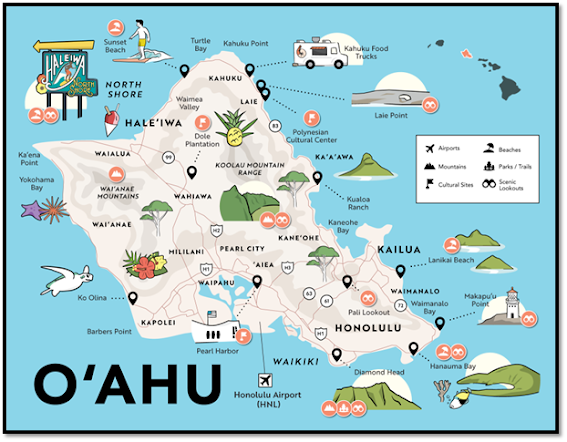HONOLULU, OAHU
History of O'ahu and Honolulu
O'ahu, the third-largest Hawaiian island, is rich
and diverse, shaped by both indigenous Hawaiian culture and the influences of
outside cultures, particularly European and American influences.
- Ancient Hawaiian
Settlements (Before 18th Century): O'ahu
was likely settled by Polynesian voyagers around 1,500 years ago. The
island's fertile valleys and abundant natural resources supported a thriving
indigenous Hawaiian population. The island was divided into several
chiefdoms, each ruled by a local chief or ali'i.
- Unification of the Hawaiian
Islands (Late 18th Century - Early 19th Century): In the late 18th century, the island of
Hawai'i's chief, Kamehameha I, embarked on a series of campaigns to unify
the Hawaiian Islands under his rule. O'ahu was conquered in 1795 after the
Battle of Nu'uanu, and Kamehameha established O'ahu as his political
center.
- Contact with Europeans
(Late 18th Century): European explorers,
including Captain James Cook, arrived in the Hawaiian Islands in the late
18th century. Their contact with the native population led to the
introduction of new diseases and changes in the Hawaiian way of life.
- Missionary Influence and Cultural
Transformation (Early 19th Century): In
the early 19th century, American Christian missionaries arrived in
Hawai'i, bringing with them new cultural, religious, and economic
influences. The introduction of Christianity and Western practices
significantly altered traditional Hawaiian society.
- Era of Hawaiian Monarchy
(19th Century): O'ahu remained an
important political and economic centre during the reign of the Hawaiian
monarchy. The capital city of Honolulu, located on O'ahu, became the hub
of commerce and government. King Kamehameha III moved the capital from
Maui to O'ahu in 1845.
- Overthrow of the Hawaiian
Kingdom (Late 19th Century): In
1893, American and European business interests, along with some members of
the Hawaiian elite, orchestrated the overthrow of Queen Lili'uokalani's
monarchy. This eventually led to the annexation of Hawai'i by the United
States in 1898.
- American Influence and
World War II (20th Century): O'ahu
gained military importance during World War II due to its strategic
location in the Pacific. The attack on Pearl Harbor on December 7, 1941,
brought the United States into World War II and had a profound impact on the
island and its people.
- Statehood and Modern O'ahu
(20th Century - Present):
Hawai'i became the 50th state of the United States in 1959. O'ahu
continued to experience rapid urbanization and economic development, with
Honolulu evolving into a major Pacific hub for tourism, business, and
military activities.
Today,
O'ahu is a vibrant blend of cultures and traditions, with a strong indigenous
Hawaiian presence alongside a diverse population representing various
ethnicities and backgrounds. Its historical significance, natural beauty, and
cultural attractions make it a popular destination for both tourists and
residents.
Honolulu Harbour
Arrived in Honolulu this morning on a bright sunny day that threatened to be very hot and humid. And it was! To prepare for entry to the US, we applied for an ESTA on line which was granted for a princely sum and of course passports and other photo ID were required. We had already undergone extensive identification to get on the ship but the mighty US required another round of ID, not only for people who were disembarking on tours of Honolulu and Oahu but for everyone. The entire ship (2000 +) was to be disembarked and be assessed by Immigration officials. Now, those who had paid for onshore tours through Princess would proceed to Immigration first and those who were doing their own thing or did not wish to go onshore were assessed last. So, after breakfast we trooped down to get our group number for the disembarkation process. Passengers then arranged themselves around various seating areas and awaited their call. We were #18 so most of the morning was quickly disappearing. Now it was back into a long snaking queue to take our turn for assessment. This included another photo being taken, documents examined, and for M, her fingerprints taken. My fingerprints weren’t required because …. wait for it ….I was over 80 years and no longer a threat! We were then free to enter the US while those who were going nowhere returned to the ship. One has to wonder what makes the US so special that these extra precautions are taken. The only other country where we experienced something similar was in China.
Coral Princess and Grand Princess (San Francisco to Sydney) arrive in Honolulu together
We then exited the terminal to walk about a half hour in the midday sun to the Australian Embassy to complete our voting responsibilities. There was a reasonably long line once again to negotiate but the process was well managed. One has to learn to be flexible when travelling. We had hoped to take the Waikiki hop on - hop off shuttle bus to do a loop of Honolulu. Instead we caught a local bus to the Ala Moana Shopping Centre, had a wander around, some lunch, and returned to the ship by mid afternoon. So, apart from casting our positive votes for the Voice, it was a day that did not meet our expectations. Let’s hope that our next stop in Nawiliwli is done with US Immigration.







No comments:
Post a Comment